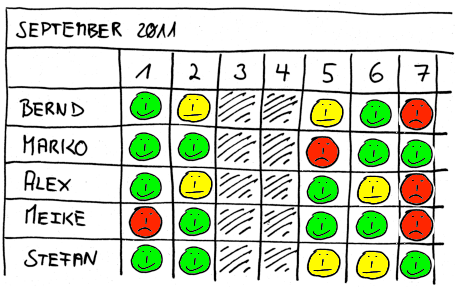
Niko-niko calendar: Measuring the team's happiness
In teams working in the technology field, the concept of happiness is becoming increasingly important as a key factor for improving productivity and the quality of the products developed. To illustrate this point, the article “Happy Workers Are More Productive: Science Proves It“ shows that happier people are approximately 12% more productive and explains why companies need to allocate resources to enhancing their employees' happiness. However, the team's happiness doesn't only improve productivity. It also impacts on the quality of the products, their alignment with customer and user needs, and the team's alignment with company goals.
A clear example of where all of these factors – and therefore the team's happiness – have a particular influence is the field of software engineering, since both the quality of the software developed and its suitability for meeting user needs, based on requirements that are often difficult to specify at the beginning of the project, are especially important. This is coupled with other factors like the need to meet deadlines – again difficult to estimate at the outset – the growing pressure to be productive to compete in the market, and the multidisciplinary nature of the teams involved, where close collaboration between all the members (and with the other players involved) is crucial.
Consequently, the team's happiness is particularly fashionable in agile development teams, as shown, for example, in the article “Un equipo “feliz” es más productivo y por ello está de moda medir la felicidad” (A 'happy' team is more productive, which is why it is fashionable to measure happiness). This shows how simple methods can be very useful for measuring the happiness of development teams. An example of this type of method is the 'niko-niko' (Japanese for 'smile') calendar, also known as the happiness calendar or happiness index.
A niko-niko calendar simply consists of a row for each team member and a column for each day, usually of the month but of the week if preferred. At the end of the day members draw a face in the corresponding box to indicate their mood, which is usually 'happy', 'indifferent' or 'sad', although interim moods can be used as well. To make it more visual, the different moods are usually associated with a color, like green for happy and red for sad.
http://agiletrail.com/2011/09/12/how-to-track-the-teams-mood-with-a-niko-niko-calendar/
Obviously, a drawing of team members' moods at the end of the day isn't enough on its own. It has to be accompanied by analyses to identify trends or specific situations, for example, that might have influenced the team's mood. True, there may be times when a quick glance at the calendar is sufficient - for example when a member's (or everyone's) mood is negative or positive for several days in a row. However, a more thorough analysis can highlight weak or hidden signs as well as patterns, and identify situations that influence the team's happiness. Our experience in analyzing this information has helped us identify different aspects that influence the team's happiness, such as the specific type of activity being performed at a given time, external factors that impact on the team, situations where the members are putting in a superhuman effort, factors that can cause demotivation, the team type (geographic spread, need for coordination with other organizations), the level of uncertainty regarding the results, the identification of needs, etc. This experience also enables us to analyze trends that can help us detect possible problems before they occur, or reinforce positive situations for the team.
The presentation “Midiendo la felicidad en equipos” (Measuring the team's happiness) shows examples of charts that can be created from the data collected.
Last but not least, when problems are detected communication between team members is vital, as is their commitment to adopt measures conducive to promoting everyone's happiness. In other words, collecting data but not measuring them is pretty pointless. The same goes for measuring data and then not adopting measures to correct the situations identified. Also, this way the team members appreciate the usefulness of these methods and are more motivated to record their mood at the end of each day.
The article “Niko-Niko: Experiencias de un año usándolos en 233 Grados de TI” (Niko-niko: Experiences in using them at 233 Grados de TI) offers another example of the experience of using a niko-niko calendar, this time in a company specializing in software management and engineering. It also explains that organizations should choose the way to analyze the information that is most useful to them and then adopt measures accordingly. For example, the whole team could be gathered on a regular basis to perform this analysis and make any decisions required. In any case, there has to be trust and transparency within the team for the exercise to work properly.
To sum up, the niko-niko calendar is clearly a useful method for managing the team's happiness which, as we have seen, is particularly critical in software development teams. Easy to implement, it also enables us to detect possible problems or changes in the environment, be they positive or negative, very quickly. Lastly, it reinforces the team spirit and increases the level of trust between the team members.

Añadir nuevo comentario